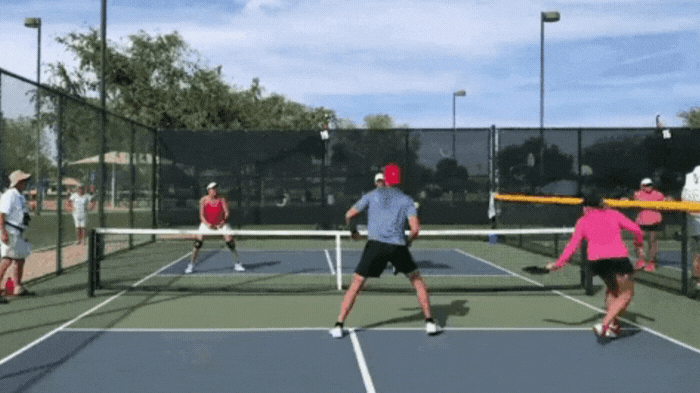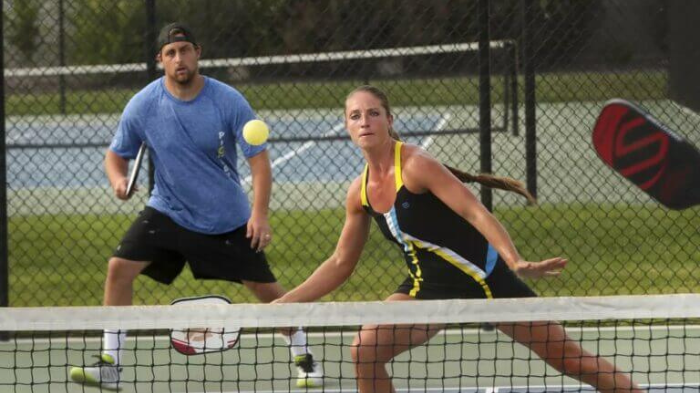Returning a lob in pickleball is a vital component that demands skill, anticipation, and strategic decision-making. It can shift the momentum in your favor and significantly impact the outcome of the game. In this blog, we are going to explain the step-by-guide on how to return a lob in pickleball.
We are also going to provide you the options for returning the lob pickleball and inform you about who returns the lob in the game of pickleball. Read this blog post, follow the steps given below for returning the lob in pickleball, and use the options provided for returning a lob in pickleball.

Who Should Return the Lob in Pickleball?
The lob in pickleball is a defensive maneuver employed to elevate the ball high and far into the opponent’s court, primarily when they are positioned near the net. Its purpose is to compel the opponents to retreat, thereby opening up an opportunity for the lobber’s team to regain control of the point.
The ideal pickleball player for returning the lob in pickleball is typically the player who is positioned in the backcourt, nearer to the baseline. This player has a higher probability of reaching and effectively returning the high shot.
On the other hand, the player positioned closer to the net in the frontcourt is more vulnerable to lobs due to their proximity to the opposing team’s offensive shots. Their positioning is generally more advantageous for quick volleys and smashes rather than retrieving elevated shots.
Of course, specific strategies and player roles may vary based on individual playing styles and team dynamics. Communication and coordination between teammates are crucial in determining who should take the lob and how they should react to it.
Steps for Returning the Lob Shot Effectively in Pickleball
To return a lob shot effectively in pickleball, follow these steps:
Anticipate And Position Yourself: To effectively anticipate a lob in pickleball, carefully observe your opponent’s position and how they are getting ready to hit the ball. As soon as you suspect a lob, position yourself a few steps behind the baseline in the backcourt area of the court. This will give you a better chance to reach and return the high shot successfully.
Establish A Balanced Stance: To stay balanced and steady, place your feet at a comfortable distance from each other, similar to the width of your shoulders. This wider base of support will contribute to your overall stability and balance while playing pickleball. Ensure your weight is evenly distributed between both feet to maintain a steady position while taking the shot.
Track The Ball: Pay careful attention to the path of the ball right from the instant it leaves your opponent’s paddle. Maintain visual contact with the ball as it gracefully arcs upwards into the air.
Position Your Paddle: Hold the paddle with both hands and position it slightly above your shoulder level. Angle the paddle to match the trajectory of the incoming lob. Remember to keep a relaxed grip on the paddle to enhance the flexibility of your wrists.
Time Your Swing: Carefully observe the trajectory of the descending ball and skillfully time your swing to intercept it precisely at the peak of its path. Aim to make contact with the ball when it reaches its highest point, maximizing your control and generating optimal power.
Execute The Shot: Extend your arms and smoothly swing the paddle upwards with poise and coordination, aiming to achieve precise contact with the ball. Keep your focus on maintaining control and executing a seamless, effortless motion.

Choose Your Shot Placement: Pay close attention to the position of your opponent and the design of the court. To make it harder for your opponents to reach you, try to return the lob deep near the baseline or at an angle towards the distant corners of the court.
Be Prepared For The Next Shot: Immediately after returning the lob, regain your ready position and be prepared to react to your opponent’s next shot. To respond effectively, it is crucial to stay agile on your feet and be prepared to move quickly.
Practice Regularly: Improve your lob return skills through consistent practice. Work on your footwork, timing, and shot placement to become more effective in returning lobs in pickleball.
By following these steps and dedicating time to practice, you can enhance your ability to return lob shots effectively in pickleball.
Options for Returning a Lob in Pickleball
When returning a lob in pickleball, you have several options depending on the situation:
Overhead Smash: If you’re close to the net and the lob is within reach, an overhead smash is an aggressive option. Position yourself near the non-volley zone line (kitchen), step forward, and swing forcefully to hit the ball downward with power, aiming to end the point or put your opponent on the defensive.
Overhead Volley: If the lob is not high enough for a smash or you’re not in the ideal position, an overhead volley is a good choice. To return a lob in pickleball, position yourself near the non-volley zone line, carefully time your shot, and make contact with the ball at its peak height. Execute a strong volley, aiming to hit the ball deep and away from your opponent, thereby maintaining control of the point.
Soft Drop Shot: When the lob is deep and you’re further from the net, a soft drop shot can be effective. Instead of hitting aggressively, lightly tap the ball over the net, placing it close to the kitchen line. This shot can catch your opponent off guard and force them to move quickly forward, giving you an advantage.
Defensive Lob: When the lob is out of your reach for an aggressive shot, employing an alternative strategy becomes crucial. In such situations, executing a high, deep lob over your opponent’s head can prove beneficial. This tactical move effectively resets the rally, providing you with precious time to regain your composure and establish a defensive position on the court.
FAQs
Improving anticipation skills comes with experience and practice. Focus on reading your opponent’s body language, racket position, and shot selection patterns. Additionally, playing more matches and observing different playing styles will help you to anticipate lobs better.
To ensure proper timing of your swing when returning a lob, focus on tracking the ball, anticipate its peak height, and synchronize your body movement with the swing. Execute a fluid and controlled swing motion to make contact with the ball at the ideal moment.
No, it is not always necessary to aim for an aggressive shot when returning a lob. Consider factors like the lob height, your position, and skill level. Alternatives such as a softer drop shot or defensive lob may be more effective. Assess the situation and choose the best shot for success.
Shot placement should be based on your opponent’s positioning. Aim to hit the lob deep and away from their reach to maintain control of the point. It is important to assess their court coverage and exploit any open areas to maximize your chances of success.
After returning a lob, swiftly move back into a defensive position on the court. Focus on footwork, maintaining balance, and being prepared for your opponent’s response. Regular practice and agility exercises will help improve your ability to recover efficiently.
Conclusion
In pickleball, the player positioned closer to the baseline in the backcourt is typically the one who effectively returns lobs in pickleball. There are four options for returning the lob in pickleball which are overhead smash, overhead volley, soft drop shot, and defensive lob.
If you follow the above mentioned steps in this blog on how to return a lob in pickleball, it will help you to improve your ability to return a lob effectively while playing pickleball. After writing this blog, we hope you will be able to return a lob well in pickleball.



